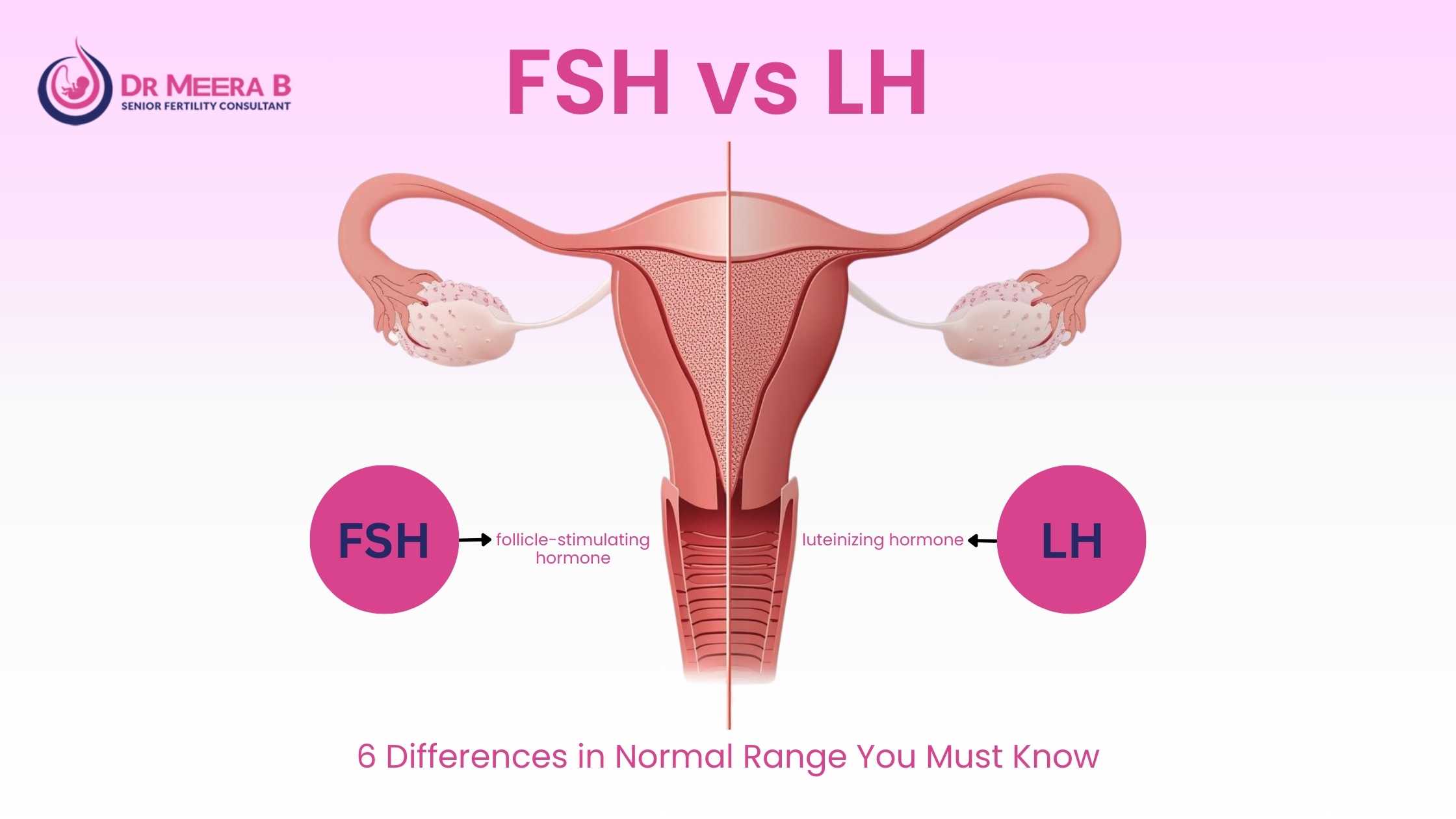What are FSH and LH hormones?
FSH (follicle-stimulating hormone) and LH (luteinizing hormone) are pituitary hormones that play a fundamental role in regulating the reproductive cycle. The FSH hormone normal range ensures the proper growth of ovarian follicles in women and supports sperm production in men, while LH levels normal trigger ovulation in women and regulate testosterone production in men. Both hormones must work in harmony for successful conception.Why understanding FSH vs LH normal range is important?
Many patients wonder: “What exactly is the FSH vs LH normal range?” The answer lies in age, gender, and reproductive stage. For women, both hormones fluctuate across the menstrual cycle, while in men, they remain relatively steady. Detecting variations helps identify conditions such as polycystic ovary syndrome (PCOS), premature ovarian failure, or hypogonadism. For couples facing delays in conception, this knowledge is the first step to effective treatment at Dr. Meera B’s place of practice, including her recent consultations at Aster PMF Hospital, Sasthamkotta.6 differences in FSH vs LH normal range
Here are the six major differences between FSH and LH when it comes to normal ranges and their impact on reproductive health:- Timing of secretion: FSH rises at the beginning of the menstrual cycle, stimulating follicle growth. LH peaks mid-cycle, causing ovulation. The surge in luteinizing hormone normal range is what triggers egg release.
- Gender-specific function: The FSH normal range is essential for egg maturation in women and spermatogenesis in men. In contrast, normal LH levels drive ovulation in women and testosterone production in men.
- Response to feedback: FSH responds more strongly to estrogen feedback, while LH is regulated by both estrogen and progesterone. This difference in control highlights why disruptions in one may not mirror the other.
- Diagnostic implications: High FSH values may indicate diminished ovarian reserve, while abnormal LH values often suggest PCOS. Understanding the exact FSH hormone normal range and luteinizing hormone normal range helps doctors pinpoint fertility issues precisely.
- Age dependence: The FSH normal range increases with age, often becoming elevated after 40, signaling reduced fertility. LH remains steadier, but spikes outside LH levels normal can reveal reproductive disorders.
- Therapeutic intervention: Fertility treatments may involve medications that either suppress or stimulate these hormones. Monitoring FSH vs LH normal range during therapy ensures the correct balance for ovulation induction or IVF cycles.
What is considered a healthy FSH hormone normal range?
In women of reproductive age, the FSH hormone normal range is usually between 4.7–21.5 mIU/mL, depending on the cycle phase. In men, the range is typically 1.5–12.4 mIU/mL. Deviations from these numbers may signal ovarian insufficiency or testicular dysfunction. At Dr. Meera B’s place of practice, accurate blood tests help identify subtle variations early, enabling timely fertility support.What is the luteinizing hormone normal range?
The luteinizing hormone normal range in women varies across the cycle: 1.9–12.5 mIU/mL in the follicular phase, 8.7–76.3 mIU/mL at the ovulatory peak, and 0.5–16.9 mIU/mL in the luteal phase. For men, normal LH levels lie between 1.7–8.6 mIU/mL. This fluctuation makes LH testing particularly crucial when evaluating ovulation timing for natural conception or assisted reproduction.How can abnormal ranges affect fertility?
When either FSH or LH falls outside their respective normal ranges, fertility potential decreases. For instance:- High FSH may indicate early menopause or reduced ovarian reserve.
- Elevated LH in women may signal PCOS, disrupting ovulation cycles.
- Low LH in men can result in reduced testosterone and poor sperm quality.
Why choose Dr. Meera B for fertility guidance?
With over three decades of experience and international training at the renowned Bourn Hall Clinic, UK, Dr. Meera B combines deep clinical expertise with compassionate care. Her recognition as MRCOG (UK) and FRCOG (UK) highlights her standing among the world’s leading gynecologists. Patients who consult her at Aster PMF Hospital, Sasthamkotta or other centers she practices at benefit from globally benchmarked fertility treatments, ensuring no couple is left without hope.How to book an appointment with Dr. Meera B
If you are concerned about your FSH vs LH normal range or facing fertility challenges, booking an appointment is easy:- Fill out the consultation form here.
- Call directly at +91 9447145101 for scheduling.
- Send a WhatsApp message using the interface on Dr. Meera B’s website.


Comments are closed